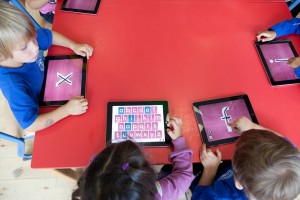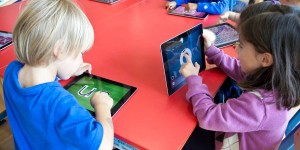
Kimberly House is the Educational Technology Specialist for the Primary School at the Bavarian International School
This is the last of a two-part article about integrating technology into the curriculum. The first part explains how a flexible schedule might look like in a school.
What about the skills?
This is often the first question asked as schools consider moving from traditional ICT lab sessions to a flexible scheduling model. A clear curriculum underpins educational technology, whether it is taught in a traditional weekly stand-alone lab session or authentically integrated. ISTE Standards for Students clearly recognize the need for skills in the use of technology. “Students demonstrate a sound understanding of technology concepts, systems, and operations.” (ISTE Standards Students, http://iste.org, ©2007
As the planning process for a unit of inquiry proceeds, the teaching team start to identify conceptual understandings and learning outcomes for the unit based on the curriculum. When educational technology is integrated into the unit, this is treated no differently from any other subject area. An example of this would be:
 Overall Expectations: Students demonstrate a sound understanding of technology concepts, systems, and operations.
Overall Expectations: Students demonstrate a sound understanding of technology concepts, systems, and operations.
Conceptual Understandings: Select and use applications effectively and productively.
Learning Outcomes:
- Format text in a word processing document (paragraphs, alignment, bold, italic, color) to present information clearly and effectively.
- Format a document to include headers, footers, table of contents and page numbers.
Traditionally, this would be taught in a stand-alone lab lesson with the intention that when the time came, students would apply these skills. In an integrated model, the students learn these skills when they are about to use them. In the flexible schedule model, the class teacher could introduce these skills and expectations as the students begin to produce their reports. The class teacher could also request the EdTech specialist to co-teach a lesson to introduce these skills. The flexible schedule allows for this to happen in the moment; just in time, not just in case.
Making the switch: where to start?
- Begin by talking to the leadership team about the purpose and need for flexible scheduling. Bring along ISTE Standards for both teachers and coaches to help facilitate the conversation. Start with the planning sessions. Getting set planning time with teachers is the foundation for success with flexible timetables.
- Get the teachers involved. How will this impact the current timetable? Will this mean taking away previously designated prep-time? If so, discuss ways to make the new system work for all parties.
- Be sure that everyone understands their role in educational technology at your school. This can be a mind-shift for some schools where anything computer related is seen as the job of the ‘computer teacher’. It may sound unimportant, but changing the name of the role within the school can be a good starting point. I find the ISTE Standards are a great place to start to define the roles and bring clarity to who is responsible for what. Discuss the co-teaching model and how you see it implemented. Be sure to consider that this new system will offer you time to directly support teachers. Teachers also have the potential now to book your time for themselves to learn or get support one on one or as a group.
- Work out the logistics of how to schedule time. There are a variety of systems available to make this easy for teachers. Our school uses an online booking system for any technology that isn’t permanently in the classrooms. Laptop carts and lab rooms can all be booked online. This allows everyone to clearly see when things are available. In terms of booking EdTech specialist support, using public calendars can be very helpful. Google Calendar, Outlook, iCal (on Mac) and services like YouCanBookMe all support shared calendars so availability is visible to everyone.
 A good overview of responsibilities in a flexible schedule school can be found here: http://blog.amersol.edu.pe/pstech/flexible-access-schedule/
A good overview of responsibilities in a flexible schedule school can be found here: http://blog.amersol.edu.pe/pstech/flexible-access-schedule/
Setting up a flexible schedule for both EdTech specialists and technology resources leads to meaningful and authentic integration of technology when combined with foundational PYP unit planning. It recognizes the needs of 21st century learners and teachers. Finally, it makes the job of the educational technology specialist much more rewarding as a valuable resource in the school.
—
Kimberly has been working at the Bavarian International School for the past 19 years. She started in the days when there was a donated PC lab and she stole time away to take primary students there with some CD Roms. She has been a part of the development of the technology programme from a class set of the old clamshell macs to a school that is now full of technology and brimming with students and teachers keen to utilise it. For the past 3.5 years she has been leading the introduction of iPads into the primary school. Throughout all of the changes, developments and improvements in technology, the one thing that has remained the same is her passion for educational technology. Kimberly is an Apple Distinguished Educator and leads workshops around technology integration as well as consults with schools who are looking to further develop their technology programmes.

Dear Kimberly,
I found both your sharing PYP blog very very useful. Thanks a lot
Can I ask you something.
If there is a topic called”unique”(about people and buildings) under “Who we Are” how ould you intrgate it within the ICT class?